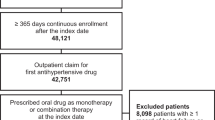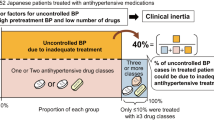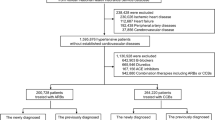Abstract
The objective of this study was to investigate stay-on-therapy patterns over 3 years among patients prescribed different classes of antihypertensive drugs for the first time. A retrospective analysis of information recorded in the drugs database of the Local Health Unit of Ravenna (Italy) was carried out on 7312 subjects receiving a first prescription for diuretics, beta-blockers, calcium channel blockers, angiotensin-converting enzyme (ACE) inhibitors or angiotensin II antagonists between 1 January and 31 December 1997. Patients were followed up for 3 years. All prescriptions of antihypertensive drugs filled during the follow-up periods were considered. The patients continuing or discontinuing the initial treatment, the duration of treatment, and the doses taken were all calculated, as well as main factors influencing the persistence rate. The drugs prescribed were predominantly ACE-inhibitors, followed by calcium channel blockers, diuretics, beta-blockers and angiotensin II antagonists. A total of 57.9% of patients continued their initial treatment during the 3-year follow-up period, 34.5% discontinued the treatment, whilst 7.6% were restarted on a treatment in the third year. Persistence with treatment was influenced by: age of patient (persistence rate increasing proportionately with advancing years), type of drug first prescribed (persistence rate higher with angiotensin II antagonists, progressively lower with ACE-inhibitors, beta-blockers, calcium channel blockers and diuretics), gender of patient (persistence was better in males), age of general practitioner (GP) (the younger the GP, the better the persistence rate) and gender of GP (better stay-on-therapy rate with male GP prescribing). In the case of patients treated continuously, mean daily dose increased progressively over the 3 years. With adequate markers, helpful data can be collected from prescription claims databases for the purpose of monitoring the persistence of patients in continuing their medication, and the quality of antihypertensive treatment in a general practice setting.
This is a preview of subscription content, access via your institution
Access options
Subscribe to this journal
Receive 12 digital issues and online access to articles
$119.00 per year
only $9.92 per issue
Buy this article
- Purchase on Springer Link
- Instant access to full article PDF
Prices may be subject to local taxes which are calculated during checkout


Similar content being viewed by others
References
MacMahon SW et al. The effect of drug treatment for hypertension on morbidity and mortality from cardiovascular disease: a review of randomised clinical trials Prog Cardiovasc Dis 1986; 29 (Suppl 1): 99–118
Dahlof B et al. Morbidity and mortality in the Swedish Trial in Old Patients with Hypertension (STOP-Hypertension) Lancet 1991; 338: 1281–1285
SHEP Cooperative Research Group. Prevention of stroke by antihypertensive drug treatment in older persons with isolated systolic hypertension: final results of the Systolic Hypertension in the Elderly Program (SHEP) J Am Med Assoc 1991; 265: 3255–3264
Miller NH, Hill M, Kottke T, Ockene IS . The multilevel compliance challenge: recommendations for a call to action; a statement for health care professionals Circulation 1997; 95: 1085–1090
Eraker FA, Kirscht JP, Becker MH . Understanding and improvingpatients compliance Ann Intern Med 1984; 100: 258–268
Mancia G et al. Blood pressue control in the hypertensive population Lancet 1997; 349: 454–457
Bittar N . Maintaining long-term control of blood pressure: the role of improved compliance Clin Cardiol 1995; 18 (Suppl III): 12–16
Wayne D . Applied Nonparametric Statistics, Second Edition PWS-KENT Publishing Company: USA 1990
Marubini E, Valsecchi MG . Emmerson M. Analysing Survival Data from Clinical Trials and Observational Studies John Wiley & Sons: June 1995
Mignani S, Montanari A . Appunti di analisi statistica multivariata, società editrice Esculapio: Bologna 1997
Jones JK et al. Discontinuation of and changes in the treatment after start of new courses of antihypertensive drugs: a study of a United Kingdom population BMJ 1995; 311: 293–295
Bloom BS . Continuation of initial antihypertensive medication after 1 year of therapy Clin Ther 1998; 20: 1–11
Bailey JE, Lee MD, Somes GW, Graham RL . Risk factors for antihypertensive medication refill failure bypatients under Medicaid managed care Clin Ther 1996; 18: 1252–1262
Okano GJ et al. Patterns of antihypertensive use amongpatients in the US Department of defense database initially prescribed an angiotensin-converting enzyme inhibitor or calcium channel blocker Clin Ther 1997; 19: 1433–1445
Monane M et al. The effects of initial drug choice and comorbidity on antihypertensive therapy compliance: results from a population-based study in the elderly Am J Hypertens 1997; 10: 697–704
Christensen DB et al. Assessing compliance to anti-hypertensive medications using computer-based pharmacy records Med Care 1997; 35: 1164–1170
Caro JJ et al. Persistence with treatment for hypertension in actual practice Can Med Assoc J 1999; 160: 31–37
Joint National Committee on Detection, Evaluation, and Treatment of Blood Pressure. The sixth report of the Joint National Committee on Prevention, Detection, and Treatment of High Blood Pressure (JNC VI) Arch Intern Med 1997; 157: 2413–2446
Colhoun HM, Dong W, Poulter NR . Blood pressure screening, management and control in England: results from the Health Survey for England 1994 J Hypertens 1998; 16: 747–752
Marques-Vidal P, Tuomilehto J . Hypertension awareness, treatment and control in the community: is the ‘rules of halves’ still valid? J Hum Hypertens 1997; 11: 213–223
Cocchi R et al. Cardiovascular risks in hypertensivepatients: results of the Pandora project J Nephrol 2002; 15: 29–34
Fletcher SW, Pappius EM, Harper SJ . Measurement of medication compliance in a clinical setting Arch Inter Med 1979; 139: 635–638
Stephenson BJ et al. Is this patient taking the treatment as prescribed? JAMA 1993; 269: 2779–2781
O'Brian Smith E et al. Clinic attendance in the hypertension detection and follow-up program Hypertension 1982; 4: 710–715
Goldberg AI, Dunlay MC, Sweet CS . Safety and tolerability of losartan potassium, an angiotensin II receptor antagonist, compared with hydrochlorothiazide, atenolol, felodipine ER, and angiotensin-converting enzyme inhibitors for the treatment of systemic hypertension Am J Cardiol 1995; 75: 793–795
Acknowledgements
Funding: Ravenna Local Health Unit and Merck Sharp & Dohme Italia S.p.A. The co-operation in this study of Dr Alessandro Capone is gratefully acknowledged.
Author information
Authors and Affiliations
Corresponding author
Rights and permissions
About this article
Cite this article
Degli Esposti, E., Sturani, A., Di Martino, M. et al. Long-term persistence with antihypertensive drugs in new patients. J Hum Hypertens 16, 439–444 (2002). https://doi.org/10.1038/sj.jhh.1001418
Received:
Revised:
Accepted:
Published:
Issue Date:
DOI: https://doi.org/10.1038/sj.jhh.1001418
Keywords
This article is cited by
-
Non-adherence to antihypertensive pharmacotherapy in Buea, Cameroon: a cross-sectional community-based study
BMC Cardiovascular Disorders (2018)
-
Medication adherence and visit-to-visit variability of systolic blood pressure in African Americans with chronic kidney disease in the AASK trial
Journal of Human Hypertension (2016)
-
Long-term persistence to mono and combination therapies with angiotensin converting enzymes and angiotensin II receptor blockers in Australia
European Journal of Clinical Pharmacology (2016)
-
Quality of Life in Treatment-Resistant Hypertension
Current Hypertension Reports (2015)
-
Younger Females Are at Greater Risk of Vasodilation-Related Adverse Symptoms Caused by Dihydropyridine Calcium Channel Blockers: Results of a Study of 11,918 Japanese Patients
Clinical Drug Investigation (2014)



